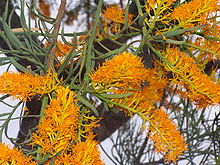Western Australian Christmas tree
| Nuytsia | |
|---|---|
 |
|
| Scientific classification | |
| Kingdom: | Plantae |
| (unranked): | Angiosperms |
| (unranked): | Eudicots |
| (unranked): | Core eudicots |
| Order: | Santalales |
| Family: | Loranthaceae |
| Genus: |
Nuytsia R.Br. ex G.Don |
| Species: | N. floribunda |
| Binomial name | |
|
Nuytsia floribunda (Labill.) R.Br. ex G.Don |
|
| Synonyms | |
|
|
Nuytsia floribunda is a hemiparasitic plant found in Western Australia. The species is known locally as the Christmas tree, displaying bright flowers during the Christmas season. The Noongar names for the plant are moojar, moojerool, munjah and mutyal.
The habit of the species is a tree up to 10 metres (33 ft) high, or as a shrub. The rough bark is grey-brown. Flowers are a vivid yellow-orange, appearing between October and January.
It is a root hemiparasite, is photosynthetic and mainly obtains water and mineral nutrients from its hosts. The haustoria arising from the roots of Nuytsia attach themselves to roots of many nearby plants and draw water and therefore nutrients from them. Almost all species are susceptible to attack; haustoria have even been found attached to underground cables. In natural settings Nuytsia withdraws relatively little from each individual host, but is attached to so many other plants that the benefit to this hemiparasitic tree is likely to be considerable.
The first description of Nuytsia floribunda was published by Jacques Labillardière in his 1805 work Novae Hollandiae Plantarum Specimen, as Loranthus floribundus, the specific epithet describing the profuse flowers he would have observed at Esperance. The botanist Robert Brown published a remark on the species in 1831, giving a new genus name without a formal description. The description was published by George Don using Brown's name Nuytsia, an epithet that commemorates the seventeenth-century Dutch explorer and colonial official Pieter Nuyts.
A member of the Loranthaceae, a family composed almost entirely of epiphytic mistletoes within the Santalales, the genus Nuytsia is monotypic.
Nuytsia floribunda is well known in Southwest Australia, where it is named the Christmas tree, the common name outside of this region is Western Australian Christmas tree. The appearance of abundant flowers in summer is a spectacular display. Although Nuytsia seeds germinate readily and seedlings are easy to grow for a year or two, cultivation of the species to maturity is regarded as difficult, with little success outside of its native habitat. It appears on a variety of soil types throughout Southwest Australia, the distribution of the species extends to the east of the Esperance Plain and to the north on the Geraldton Sandplains.
...
Wikipedia
